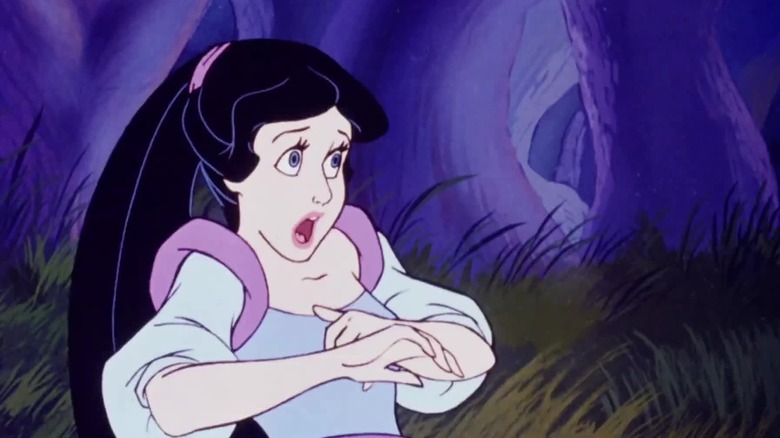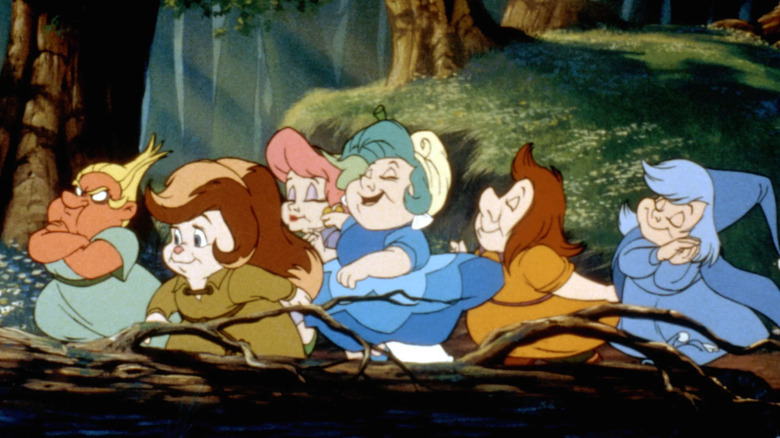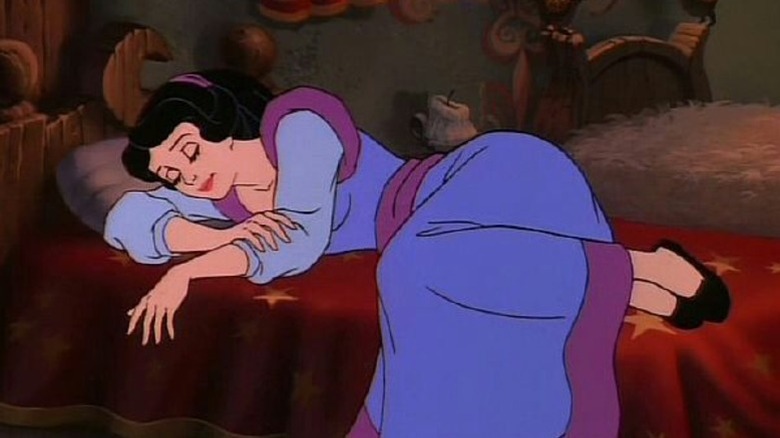The Unofficial Snow White 'Sequel' That Disney Forced To Change Its Name
We may receive a commission on purchases made from links.
John Howley's 1989 animated film "Happily Ever After" was conceived as a sequel to the "Snow White" fairy tale. Its story extrapolated partly from the earliest published version by the Brothers Grimm but also partly from the 1937 Disney-produced film "Snow White and the Seven Dwarfs." "Happily Ever After" didn't re-use any of Disney's designs, voices, characters, or concepts (at least none that weren't already in the Public Domain), but one can see how Howley's film relied on vague cultural echoes that Disney originally yawped into the mass consciousness. Snow White (Irene Cara), for example, had almost identical hair and wore a similar dress to the version of the character designed by Walt Disney.
"Happily Ever After" staggered during its brief theatrical run, making only $3.3 million at the box office on a modest $6.8 million budget (although it was later heavily rented on VHS). One of the reasons it struggled, however, was because Disney didn't like it. Notably, Disney felt that Filmation, the company that made "Happily Ever After," was ripping off "Snow White and the Seven Dwarfs." Indeed, Filmation was already on Disney's s***list after a 1987 lawsuit.
It seems that Disney, always notoriously litigious, felt that Filmation's 1986 animated feature "Pinocchio and the Emperor of the Night" was just a little bit too similar to Disney's 1940 film "Pinocchio." (Never mind that the character of Pinocchio comes from Carlo Collodi's public domain novel of the same name.) Perhaps angering Disney, Filmation won that case, arguing that Disney had no legal claim to the Pinocchio character. (Which, again, is true.) The matter is discussed in Jerry Beck's invaluable book "The Animated Movie Guide."
Disney came back when "Happily Ever After" opened domestically in 1993, though, claiming once again that Filmation had ripped the studio off to make its "Snow White" movie. The original working titles for the film were "Snow White: The Adventure Continues," "The Further Adventures of Snow White," and — and I love this one — "Snow White in the Land of Doom."
Disney sued Filmation over its Snow White film, insisting the title be changed
"Happily Ever After" Takes place after the Evil Queen from "Snow White" had been defeated, with Snow White preparing to marry her handsome Prince (Michael Horton). As it so happens, though, the Evil Queen has an equally evil brother named Maliss (Malcolm McDowell), a wicked sorcerer. When he learns from the Magic Mirror (Dom DeLuise) that his sister was slain, he begins to plot his revenge. He then turns himself into a dragon, transforming Snow White's kingdom into a wasteland at the same time. Snow White is thus forced to fight Maliss with the aid of the seven sisters of the Seven Dwarfs. The Dwarfelles, as they call themselves, are named Muddy (Carol Channing), Sunburn (Sally Kellerman), Blossom (Zsa Zsa Gabor), Marina (Linda Gary), Critterina (also Gary), Moonbeam (Tracey Ullman), and Thunderella (also Ullman). They further enlist Mother Nature (Phyllis Diller) in their scheme.
Other cast members include Jonathan Harris, Ed Asner, and, of course, Frank Welker. The film boasted an all-star ensemble well before big-name actors were joining animated features on the regular.
Once the film opened in the Philippines in 1989, Disney was already all over "Happily Ever After" and Filmation. Because of the "Pinocchio" lawsuit, Filmation was required to make its animated fairy tale legally distinct from anything Disney had ever made. As such, the title was changed from "Snow White: The Adventure Continues" to "Snow White and the Dwarfelles" (the Dwarfelles were originally intended to be the Seven Dwarfs, but had to be gender-flipped in post) and then, finally, to "Happily Ever After." Sadly, the movie's stateside rollout was delayed by several years because Filmation had shuttered its doors in 1989, leaving the film to find a new distributor in the form of the First National Film Corporation. (Hence the movie not debuting in the U.S. until 1993.)
Disney rubbed salt in the wound
Of course, not satisfied that it had already caused enough trouble for Filmation, Disney decided to kick "Happily Ever After" while it was down. The film was released in U.S. theaters on May 28, 1993 ... and Disney decided to re-release "Snow White and the Seven Dwarfs" the following July. With a well-moneyed ad-campaign, Disney more or less tried to bury "Happily Ever After." Given that the film bombed, one can say that Disney was successful.
Lest you think the "Seven Dwarfs" re-release was a coincidence, realize that Disney has pulled stunts like this before. When Don Bluth's 20th Century Fox film "Anastasia" was scheduled for release in 1997, Disney hustled to re-release its own 1989 hit "The Little Mermaid" on the same day. Because of this, the animation audience was split between the two movies, causing "Anastasia" to open at #2 at the box office and "Mortal Kombat: Annihilation" to rule the weekend (with "The Little Mermaid" coming in at #3). This was, in fact, a concerted effort by Disney to quash the competition.
This all came after an incident in 1992 when "FernGully: The Last Rainforest" was in production. Also a Fox film, Disney resented that another studio was trying to enter the animation market. Its executives were also upset that their "Aladdin" star, Robin Williams, refused to drop out of the Fox film in favor of theirs. As such, one of Disney's head honchos at the time, Jeffrey Katzenberg, tracked down the animation studio that was making "FernGully" ... and bought it. In other words, the Mouse House deliberately tried to slow down production on "FernGully." It was quite the devious move.
Would "Happily Ever After" have been a hit without Disney constantly blocking it? Who can say? But its theatrical release would have certainly been smoother.


